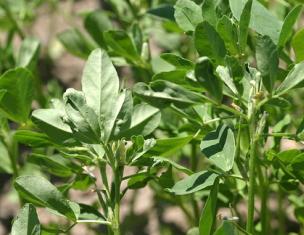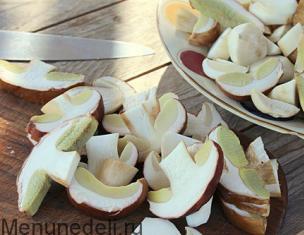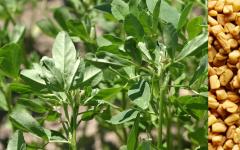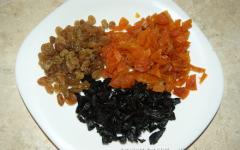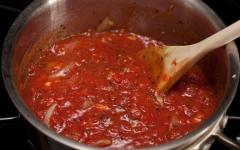A seasoning that is difficult to even taste. But in fact, adjika in Armenian is made in several ways and not all of them are overtly spicy, but they all have a spicy and fragrant aroma.
Features of preparing traditional Armenian adjika
In general, adjika is considered a traditional Abkhaz dish, well, as a last resort. But it reached Armenia much later, having undergone many changes along the way. But over the past few centuries, this aromatic seasoning has been prepared everywhere in the Caucasus, and it is the Armenian adjika, oddly enough, that is considered the least spicy of all its classic variants. Perhaps this is due to the fact that in Armenia it is usually prepared with the obligatory addition of tomatoes, although in the traditional version tomatoes are not added to adjika at all.
Armenia, like any Caucasian country, is famous for the use of a large number of herbs, especially wild ones, but special preference is given to cilantro, parsley, basil, mint, tarragon and thyme. But the herb that is necessarily used in Armenian adjika is shambhala, or chaman, as it is called in Armenia.
Attention! This wonderful spice with a nutty taste also has other names - fenugreek, fenugreek, Greek hay, camel grass.

Garlic is used, as a rule, in small quantities and is not at all an obligatory component, as in adjika recipes of other Caucasian peoples. In the Armenian recipe, it is better to use its purple varieties.
Well, using hot pepper is a must. Without it, any adjika simply turns into tomato paste. Of course, if you want to prepare real Armenian adjika, you need to find fresh hot pepper. And it doesn’t matter what color, red or green. Although it usually has less pungency.
Comment! But as a last resort, it is allowed to use dry ground hot pepper instead of fresh vegetables.
According to some recipes for making adjika in Armenian, the addition of vinegar is allowed. In these cases, it is better to use natural wine, balsamic or apple cider vinegar. Its use is justified only by the fact that it increases the shelf life of the seasoning.
Salt can be used as rock, table or sea salt.
Finally, when making Armenian adjika, it is important to grind all the components well. A meat grinder is best for these purposes, but you can also use a powerful blender.
Armenian adjika recipe
Armenian adjika can be made according to the classic recipe, preserving all the beneficial substances of the components that make up its composition. But there are also other recipes using which you can prepare an equally tasty and aromatic seasoning, but it will be stored for a long time under any conditions.

Adjika Armenian classic
To make Armenian adjika according to the classic recipe, you will need the following ingredients:
- 5 kg of ripe tomatoes;
- 500 g chili pepper;
- 1 kg garlic;
- 50 g of shamballa (chamana - usually in the form of dry powder);
- 60 g salt.
And preparing it is very simple.
- The tomatoes are washed, excess parts are cut out and twisted using a meat grinder.
- Add salt and shamballa to the twisted tomatoes and stir well.
- The stems of the chili peppers are separated after washing.
- The garlic is peeled and divided into cloves.
Advice! To make garlic easier to peel, soak it in cold water.
- Grind pepper and garlic through a meat grinder. In this case, it is advisable to protect your hands with gloves if there are even the slightest wounds on them.
- All ground ingredients are placed in a deep enamel container, mixed, covered with a lid and left to ferment at room temperature for 12-14 days.
- The resulting mass must be mixed every day.
- After two weeks, the finished adjika is transferred into small, clean, sterile jars, covered with lids and stored in the refrigerator.

With hot pepper and garlic
Armenian adjika, prepared according to this recipe, is sealed for the winter under tin lids, so all products are subject to mandatory heat treatment.
You will need:
- 3 kg of tomatoes;
- 2 kg bell pepper;
- 300 g hot chili pepper;
- 200 g garlic;
- 30 g shambhala (chamana);
- 30 g hops-suneli;
- 300 g vegetable oil;
- 90 g sea salt;
- 100 g sugar;
- 3 tbsp. spoons of vinegar.
Preparing adjika according to this recipe is a little more difficult, but faster in terms of overall time.
- The tomatoes are crushed in a meat grinder and boiled over medium heat until their volume is reduced by 1.5 times.
- Add salt to boiled tomatoes.
- At the same time, grind hot and sweet peppers in a meat grinder and simmer the resulting mass in 300 g of oil in a cast iron frying pan for 40-50 minutes.
- Combine tomatoes and peppers, add garlic chopped in a blender and simmer for another 10-15 minutes.
- Add shamballa, suneli hops and sugar.
- Simmer for another 5-10 minutes over low heat, add vinegar and place in pre-sterilized jars.

With greens
A unique recipe for Armenian adjika for the winter, which does not contain tomatoes at all. But a rich selection of fresh herbs will make its taste and aroma irresistible.
Prepare:
- 8-10 pieces of hot green pepper;
- 1 kg yellow or green sweet bell pepper;
- 200 g fresh cilantro;
- 50 g each of dill and parsley;
- 100 g mint;
- 300 g basil;
- 200 g tarragon (tarragon);
- 50 g of shamballa (the only herb that is used in dry form);
- 2-3 heads of garlic;
- 1 teaspoon coriander seeds;
- 2 cups shelled walnuts;
- 60 g salt minimum.
The hardest part of this recipe is finding all the ingredients, which need to be as fresh as possible. And the process of preparing this dish can only bring pleasure.

- Peppers of both types are freed from the tails and seed chambers and cut into small pieces.
- The garlic is peeled and divided into cloves.
- The greens are washed, dried and chopped, not very finely and not very coarsely.
- Peppers, garlic, herbs and nuts are placed in a blender bowl and crushed into a single mass.
- Add salt, coriander, shamballa to it and mix the mass thoroughly using a wooden spoon. Let it sit in a warm place for about 30 minutes.
- Sterilize the jars and place the prepared adjika in them, cover with sterile lids and store in the refrigerator.
Adjika in Armenian for the winter
This recipe can be called one of the most delicious and most versatile, since it is suitable for use in a wide variety of dishes.
The necessary ingredients are no longer as rare and exotic as in the previous recipe and finding them will not be difficult:

It is also not difficult to prepare Armenian adjika according to this recipe.
- Tomatoes take the longest to cook, so they start with them - wash them, remove where the stem attaches, twist them through a meat grinder and put them on low heat to simmer until some of the liquid has evaporated.
- While the tomatoes are simmering, peel both types of peppers. The seeds and membranes are removed from the sweet. Only the tails of hot peppers are removed, and the seeds are left.
- The greens are washed and dried.
- The garlic is peeled and divided into cloves.
- Peppers and herbs are passed through a meat grinder.
- Mix what's left of the tomatoes, chopped peppers and herbs over the fire, add spices, shamballa, and coriander seeds.
- Boil for another 10-15 minutes until the mixture is thick enough to resemble oatmeal.
- At the same time, grind the garlic in a meat grinder or using a press.
- Remove the adjika from the heat, add chopped garlic to it and mix thoroughly, achieving as much homogeneity as possible.
- Hot adjika is laid out in sterile glass containers, screwed in and left to cool in a convenient place.

Terms and conditions of storage
Armenian adjika made without heat treatment should be stored exclusively in the refrigerator. In this case, it can serve from 3 to 5 months, somewhat losing its sharpness and freshness over time.
Adjika prepared according to recipes with heat treatment and rolled for the winter can be stored both in the cellar and under normal room conditions. In a room, its shelf life will be no more than 6-8 months, while in a cool cellar it can last for several years.
Conclusion
Armenian adjika is an easy winter seasoning to make, but in terms of taste, aroma, and versatility of use, it is difficult to find an alternative to it.
- Red bell pepper – 5 kg
- Red hot pepper – 0.5 kg
- Garlic – 0.5 kg
- Tomato paste – 0.5 kg
- Sunflower oil – 0.25 ml
- Parsley – 1 large bunch
- Celery – 1 large bunch
- Khmeli-suneli – 15 g
- Sugar – 1 glass
Characteristics of the final product
Adjika in Armenian is a moderately spicy, fragrant, vitamin-rich appetizer made from fleshy large red bell peppers with the addition of bitter capsicum and garlic. Prepared for the winter, rolled into jars.
According to the classic recipe, it is prepared with tomato paste, but it can be made using ripe fleshy tomatoes, having first cooked the tomato from them. For the amount of pepper suggested in the recipe, you need to take 3 kg of tomatoes.
When ready, Armenian adjika has a pasty consistency of a bright, rich red color.
The degree of spiciness of adjika greatly depends on the quality of the hot pepper. You can vary it to your taste, reducing it down to 2-3 pods if you want children to eat adjika with pleasure in the winter. But it’s not wise to give up hot peppers completely: they contain the largest amount of vitamin C compared to other fruits.
At the end you should get 9-10 liters of finished product
The procedure for preparing adjika in Armenian
- We clean the sweet pepper from the core: seeds and membranes. Just wash the bitter, no need to remove the seeds. Grind in a meat grinder or other kitchen appliance to small particles. Chop the garlic in the same way. Greens are cut with a knife
- In a large saucepan or basin, cook the ground peppers for 20-30 minutes.
- Add tomato paste, oil, garlic, herbs, salt, sugar and suneli hops to the boiling pepper. Cook over low heat for another 20 minutes.
- Wash glass jars with a capacity of 0.5-1 liters and pour boiling water over them.
- Pour hot adjika in Armenian style into jars, roll it up, and wrap it in a blanket to cool slowly.
How to store and use
Adjika prepared in this way can be stored in the pantry for up to two years. Don't forget to put the opened jar in the refrigerator.
Armenian adjika will decorate the festive table and give boiled potatoes and noodles a piquant taste. Meat dishes will acquire new shades of taste.
You can simply put a spoonful of adjika on a slice of bread and have a quick snack.
Bon appetit!
A maximum of healthy products can be placed in one dish; it will not be difficult to implement your plan, because all the ingredients for it are easily accessible. Armenian adjika is such an extraordinary miracle dish; the recipe for its preparation impresses with its simplicity and amazingly tasty result. It’s easy to make a snack truly savory - add spices and a little special herbs to its composition, then it will turn out as delicious as ever.
Many people know how to make Armenian adjika at home for the winter, but only a few know how to unobtrusively emphasize its spicy tomato taste, and at the same time the spiciness of a dish, without using unnecessary additives.
The secret to successfully preparing an Armenian tomato appetizer is the addition of greens, and, as a rule, it is based on cilantro, while other types of greens are at the discretion of the hostess.
Armenian adjika with herbs: step-by-step recipe
Ingredients
- Hot capsicum— 2 kg + -
- Tomato paste - 300 g + -
- Cilantro - a bunch or 3 g + -
- Coriander – 3 g + -
- — 250 g + -
- — 3 kg + -
- — 1 tbsp. or to taste + -
- - 1 glass + -
- — 250 g + -
Cooking homemade Armenian adjika
- We thoroughly wash the bell pepper and remove all the seeds.
- Wash the hot pepper and remove the seeds. To avoid burning your skin, wear gloves when cleaning the chili.
- Peel the garlic and onions, wash them, and grind them in a meat grinder.
- Pass the onion through a meat grinder separately from the garlic.
- Grind peppers (bell and hot) separately from garlic and onions.
- Finely chop the cilantro, grind the coriander in a special culinary mill.
- Add vegetable oil to a hot frying pan, then pour chopped onions into it.
- Simmer the slices over the fire for 5 minutes, then add the twisted garlic to the onion.
- We also simmer it for 5 minutes, after which we pour the pepper mass into the frying pan.
- Simmer all ingredients over heat until light golden brown. As soon as the products are stewed, pour them with tomato paste, sprinkle with ground coriander, salt and finely chopped cilantro. Simmer the dish on the fire for another 20 minutes.
- We put the finished Armenian adjika into jars sterilized in the oven, roll them up with lids and put them in a cool place for storage. Just let the “Armenian” contents cool first before you take it to the cellar or pantry.
Adzhika rolled up in this way will last longer, and its taste becomes more intense. This appetizer has a more pronounced spiciness, which is ideal for lovers of spicy dishes. Using almost all the same ingredients, Armenian adjika can be prepared a little differently.
Armenian adjika: recipe with spicy dressing
This appetizer, so delicious for thrill-seekers, takes no longer than usual to prepare.
To prepare it, we leave all the above products in the list of ingredients (with the same proportions) as in the recipe above. Let’s just slightly adjust the ingredient composition by adding a few new products.
Additional ingredients for Armenian adjika
- Chili pepper – 300 g (in this recipe we will take hot capsicum in much smaller quantities: not 2 kg, as in the previous recipe, but only 300 g);
- Fresh tomatoes – 3 kg;
- Sugar – ½ cup;
- Vinegar 9% - 100 ml;
- Sea salt - ⅓ cup;
- Khmeli - suneli - 30 g.

Making sauce at home
- Thoroughly grind the tomatoes into puree using a meat grinder/blender.
- Place the tomato puree on the stove.
- Wash the chili and bell pepper, remove the seeds, twist, and add to the boiling tomato puree.
- Mix the ingredients in the pan thoroughly and cook for 10 minutes.
- Add vegetable oil to the homemade snack, mix it, simmer over moderate heat for another 1 hour.
- While the Armenian adjika is boiling, we make a dressing for it with our own hands: mix chopped herbs in a blender (and this can be not only cilantro, but also dill, parsley, lettuce, basil, etc.), sugar, salt, chopped garlic, hops - suneli.
- Add vinegar and prepared dressing to the boiled adjika. Stir the appetizer and leave to cool for a while.
Place the cooled product in sterilized jars and seal them with lids. Armenian adjika (the recipe for which we reviewed in detail) is ready, put it in the refrigerator for storage.

Spicy adjika in Armenian can be served as an appetizer for fish, potato, and meat dishes. You can also spread adjika on bread, using it to make a delicious homemade sandwich. Adjika is also ideal for any side dishes or porridges. Its spicy-spicy taste will decorate any dish, giving it a special taste and spiciness.
If you are going to prepare an appetizer for the whole family, which is suitable for both the everyday menu and the holiday menu, then you can’t think of a better dish than Armenian adjika. The recipe for adjika at home is simple, and it also takes little time to prepare.
These advantages, combined with a spicy taste, make the dish truly loved by many families. Have fun preparing a classic Armenian appetizer - and let adjika become the signature dish in your usual culinary menu.
Bon appetit!
Traditional Caucasian adjika is prepared from hot peppers, herbs and spices with the addition of salt, sometimes sweet pepper is included to give the seasoning a slightly milder taste. But even in this case, it seems too sharp to many of our compatriots. They prefer the Armenian version of adjika, which is prepared with the addition of tomatoes, tomato sauce or paste. Armenian adjika for the winter can be prepared according to different recipes; there is even a way to prepare it without cooking. This makes it possible to choose a spicy seasoning option for almost any taste.
Cooking features
The technology for preparing adjika in Armenian can be different. But there are several features of canning this spicy seasoning, knowledge of which will be useful in any case.
- Products for adjika are crushed carefully. If you prepare the seasoning in large quantities, it is advisable to use a meat grinder. To obtain a seasoning with the smoothest consistency possible, it is advisable to mince the vegetables twice, and it would be a good idea to peel the tomatoes before using them.
- The spiciness of adjika will be influenced not only by the amount of garlic and pepper, but also by their variety. Also, to obtain a seasoning with a more pungent taste, it is recommended to add hot pepper along with seeds and partitions; a milder version of the sauce can be prepared if the pepper is cleared of seeds before grinding and the partitions inside the pods are removed.
- Armenians love seasonings with herbs. They often add cilantro to sauces, sometimes parsley, basil, and celery. To give adjika properties characteristic of Armenian cuisine, you can add more greens and ground coriander seeds to it. Khmeli-suneli seasoning will also not be superfluous.
- To prepare adjika, you need to peel a large amount of pepper and garlic. These products have burning properties and can leave a burn on the skin. When working with them, hands should be protected with gloves.
- It is necessary to close adjika in Armenian style in jars washed with soda and sterilized. The lids for them also need to be sterilized by boiling. Plastic lids are only applicable if the workpiece is in the refrigerator. To store the sauce indoors, even in a cool room, it should be covered with metal lids to ensure a tight seal.
The storage conditions for the seasoning depend on the method of its preparation. Armenian adjika, made without cooking, can only be stored in the refrigerator, and no more than 4-6 months. Hot-cooked adjika can be kept at room temperature and will not spoil for at least a year.
Adjika in Armenian with tomato paste
Composition (for 4 l):
- bell pepper – 3 kg;
- bitter capsicum – 2 kg;
- tomato paste – 0.3 kg;
- garlic – 0.25 kg;
- onions – 0.25 kg;
- vegetable oil – 0.25 l;
- salt – 20-40 g;
- ground coriander – 3-5 g;
- fresh cilantro – 100 g.
Cooking method:
- Wash both types of peppers, dry them, remove seeds, and simultaneously remove the stems and partitions.
- Cut the peppers into pieces that easily fit into the socket of the meat grinder. Use this kitchen tool to puree them.
- Peel the garlic cloves, grind through a meat grinder, and place in a separate plate.
- Peel the onion, cut into small pieces, and grind with a meat grinder using a nozzle with medium holes.
- Pour oil into the bottom of a thick-bottomed pan, put the onion in it, and heat it up. After 5 minutes, add garlic, after another 5 minutes, add pepper.
- Simmer over low heat for 20 minutes.
- Add salt, coriander, finely chopped cilantro and tomato paste. Stir, simmer for another 10 minutes.
- Sterilize jars and matching lids.
- Divide the sauce into jars and seal them tightly.
Video recipe for the occasion:
After cooling, the jars of spicy Armenian adjika can be put away in the pantry or any other room in which you are used to storing supplies for the winter.
Adjika in Armenian with tomatoes
Composition (for 4.5-5 l):
- tomatoes – 3 kg;
- bell pepper – 3 kg;
- garlic – 0.3 kg;
- hot pepper – 0.3 kg;
- sugar – 100 g;
- salt – 40 g;
- hops-suneli – 30 g;
- table vinegar (9 percent) – 100 ml;
- vegetable oil – 0.2 l;
- fresh cilantro – 100 g;
- fresh basil – 100 g.
Cooking method:
- Cut the tomatoes crosswise and place them in boiling water. After 3 minutes, remove with a slotted spoon and transfer to a container filled with cold water. Remove the skin from the cooled tomatoes. Grind the pulp with a blender or grind through a meat grinder and place in a saucepan.
- Peel sweet and hot peppers, cut into large pieces and chop in the same way as tomatoes. Place in a bowl.
- Pass the garlic through a special press or chop it in another way. Place in a separate plate or bowl.
- After washing and drying the greens, also chop them using a meat grinder and mix with garlic.
- Add salt, sugar, suneli hops and vinegar to the garlic. Mix well.
- Wash and sterilize the jars and metal lids that go with them.
- Place a pan of tomato puree on the stove. Bring it to a boil over low heat. When the puree boils, add chopped pepper to it and stir.
- Wait for the contents of the pan to boil again. Add oil to boiling vegetable puree and stir.
- Simmer the vegetable mass for 30-60 minutes until it reaches the optimal thickness from your point of view.
- Add the rest of the ingredients and simmer the appetizer for another 5 minutes.
- Place hot adjika into prepared jars and seal tightly.
According to this recipe, adjika turns out less spicy than the previous one, and a little more liquid. It will appeal to those who prefer moderately hot dishes. Canned food made according to the recipe can be stored at room temperature.
Adjika in Armenian without cooking
Composition (per 5 l):
- tomatoes – 5 kg;
- garlic – 1 kg;
- hot capsicum – 0.5 kg;
- salt - to taste.
Cooking method:
- After dousing the tomatoes with boiling water, peel and grind until pureed. Add salt to taste.
- Grind the peeled garlic cloves and pepper through a meat grinder.
- Mix chopped pepper and garlic with tomato puree. Mix well.
- Leave for 1.5-2 weeks at room temperature - the adjika should ferment. To prevent it from souring, stir it daily (more often, but not less often).
- Place the snack in clean jars and bottles. Close them and put them in the refrigerator.
The sauce made according to this recipe can satisfy the requirements of even a picky gourmet. The disadvantage of this liquid seasoning is the need to store it in the refrigerator and its relatively short shelf life (up to 6 months).
Adjika in Armenian is a juicy spicy seasoning that many people like. Unlike Georgian adjika, it is made for the winter with the addition of tomato paste or fresh tomatoes.
Traditional Abkhaz adjika is prepared using hot pepper, garlic, salt and herbs.
We suggest not limiting yourself to just the classics with such a variety of ingredients for a sizzling seasoning. Check out our easy, proven recipes!
How to cook adjika: 3 rules
To ensure that adjika has a rich color and thick consistency, choose the brightest and most fleshy vegetables.
It is better to use rock salt, since pure sodium chloride is a powerful preservative, and iodized salt can cause fermentation and softening of vegetables.
Unpeeled hot pepper gives adjika its special pungent taste. If you remove the seed pods from the pods, the flavor of the sauce will be milder. And don't forget to use rubber gloves to avoid getting pepper burns!
Green adjika
Photo: dinasdays.com Abkhazia’s calling card. This adjika is served with many dishes and always with spit-roasted lamb.
What do you need:
- 6–8 large hot green peppers
- 1 head of garlic
- 1 bunch of cilantro
- 1 tbsp. spoon of salt
How to prepare green adjika:
Cut the pepper into small pieces without removing the seeds.
Grind the pepper and garlic in a mortar or mince several times.
Add salt, stir and leave to brew for 15–20 minutes.
The incomparable host of the program Lara Katsova shared with us her family recipe for adjika, turn on the video!
Russian adjika "Ogonyok"

Photo: natalielissy.ru For borscht, salted lard with black bread and boiled potatoes with herring - adjika is ideal for traditional Russian dishes. It can be used to prepare sauces for meat and even seasoning for pickle and cabbage soup.
What do you need:
- 1 kg tomatoes
- 1 kg sweet pepper
- 400 g garlic
- 200 g hot pepper
- 150 g parsley root
- 1 tbsp. spoon of salt (to store adjika for more than 1–2 months, double the amount of salt)
How to prepare Russian adjika “Ogonyok”:

Hot adjika with basil

Photo: natalielissy.ru Spicy! Very spicy! Even hotter! The versatility of the recipe is that this adjika can be used not only for meat dishes, but also for sandwiches, sauces, soups and even pasta.
What do you need:
- 500 g hot red pepper (you can add a couple of green peppers)
- 400 g garlic
- 2 bunches green basil
- 1 bunch of cilantro
- 1 bunch of parsley
- 2 tbsp. spoons of salt
How to prepare hot adjika with basil:

Nut adjika

Photo: thinkstockphotos.com Adjika is not adjika if it does not contain nuts, as they say in the Caucasus. Subtle pleasant aroma, thick consistency and rich piquant taste - that’s what makes adjika real!
What do you need:
500 g tomatoes
400 g walnuts
200 g red bell pepper
3 heads of garlic
2–3 hot peppers
1 bunch of cilantro or parsley
4 tbsp. tablespoons refined sunflower oil
2 tbsp. spoons of vinegar 9%
1 teaspoon salt
How to prepare nut adjika:
Remove seeds from bell peppers, wash and dry the greens.
Cut out the stems of the tomatoes.
Grind tomatoes, peppers, garlic, nuts and herbs in a blender or mince twice.
Add sunflower oil, vinegar and salt to the prepared mass.
Stir and serve immediately!
Gorloder, or Siberian adjika with horseradish

Photo: loverofcreatingflavours.co.uk A recipe from Siberia is quite capable of providing healthy competition to fiery sauces from sunny Abkhazia. The basis of the horloger is vigorous horseradish root. Suitable for meat and fish dishes, corned beef, and especially for barbecue and homemade grilled sausages.
What do you need:
- 500 g tomatoes
- 50 g horseradish root
- 50 g garlic
- 1.5 teaspoons salt
- 1 teaspoon sugar
How to cook gorloder, or Siberian adjika with horseradish:
Grind tomatoes, garlic and horseradish in a meat grinder.
Combine all ingredients, add salt and sugar, mix.
Place in sterilized jars and roll up.
Adjika from bell pepper

Photo: thinkstockphotos.com If fiery seasoning is not your thing, prepare a lighter version of this sauce with a sweet and sour taste and a slight pepperiness. This adjika goes well with baked or boiled meat, poultry, fish, potatoes baked in foil and toast.
What do you need:
- 1 kg sweet red pepper
- 300 g garlic
- 4–6 red hot peppers
- 50 ml vinegar 9%
- 4 tbsp. spoons of sugar
- 1 tbsp. spoon of salt
How to prepare adjika from bell pepper:
Remove seeds from sweet peppers.
Pass the pepper, garlic and hot pepper through a meat grinder.
Add salt, sugar, vinegar, stir and leave to steep for 3-4 hours.
Then put into sterilized jars and store in a dark, cool place.
Adjika with apples

Photo: thinkstockphotos.com An improved and adapted adjika recipe for poultry or grilled fish. To give the sauce a more delicate taste, you can prepare it without hot pepper or reduce its amount.
What do you need:
- 1 kg tomatoes
- 500 g red bell pepper
- 500 g sour apples
- 300 g carrots
- 200 g garlic
- 50 g hot pepper
- 200 ml refined sunflower oil
- 1 bunch of cilantro
- 1 bunch of parsley
- salt - to taste
How to cook adjika with apples:
Peel all vegetables and chop together with herbs in a blender or meat grinder.
Add salt and sunflower oil.
Bring to a boil and cook over low heat for 2.5 hours.
Transfer to sterilized jars and seal.
Adjika with plums

Photo: wolvesinlondon.com Tender and soft adjika with plums goes perfectly with game, boiled potatoes and baked vegetables, chicken meatballs and pork chops.
What you need:
- 500 g plums (choose plums that are not sweet or even sour)
- 500 g bell pepper
- 2 heads of garlic
- 2 hot peppers
- 1 tbsp. tomato paste
- 100 g sugar
- 2 teaspoons vinegar 9%
- 2 tbsp. spoons of salt
How to cook adjika with plums:
Remove seeds from bell peppers and seeds from plums.
Pass sweet peppers, plums, garlic, hot peppers along with seeds through a meat grinder.
Place the crushed ingredients in a saucepan, add tomato paste, salt and sugar.
Bring to a boil and cook, stirring, over low heat for 30–40 minutes.
Add vinegar 2 minutes before the end of cooking.
Transfer the finished mixture into sterilized jars, roll up, turn over and leave until completely cooled.
Baked pumpkin adjika

Photo: thinkstockphotos.com Baked vegetables give this adjika a surprisingly delicate consistency, and pumpkin gives it an unusual and at the same time unobtrusive aroma. Light, spicy, moderately hot, with a subtle sourness.
What do you need:
- 500 g pumpkin
- 200 g apples
- 200 g bell pepper
- 200 g onions
- 1 lemon
- 1 head of garlic
- 1 bunch of basil
- 1 bunch of cilantro
- 50 ml refined vegetable oil
- 1 hot pepper
- 1 teaspoon salt
How to cook baked adjika from pumpkin:
Peel the pumpkin and onion, remove the seeds from the apple and pepper. Cut the pumpkin and onion into pieces of arbitrary size.
Wrap the pumpkin, onions, apples and peppers in foil and bake at 200°C for 35 minutes. Then peel the apple and pepper.
3. Grind all baked vegetables in a blender.
Grind the garlic, lemon and herbs in a blender into a homogeneous mass.
Combine vegetables with lemon dressing, stir and serve immediately.
Adjika from pickled cucumbers

Photo: greenishthumb.net Are there any pickles left from last year's stock? Make some hot sauce out of them! The beauty of the recipe is that this adjika can be whipped up at any time.
What do you need:
- 500 g pickled cucumbers
- 1 head of garlic
- 3 tbsp. spoons of tomato paste
- 2 tbsp. tablespoons refined sunflower oil
- apple cider vinegar - to taste
- 1 pinch ground black pepper
- 1 pinch ground red pepper
How to prepare adjika from pickled cucumbers:
Peel the cucumbers and grate them on a fine grater or chop them in a blender. If there is a lot of liquid, drain it.
Pass the garlic through a press.
Combine cucumbers, garlic, tomato paste, vegetable oil, vinegar and spices.
Stir and leave in the refrigerator for 1-2 hours.



